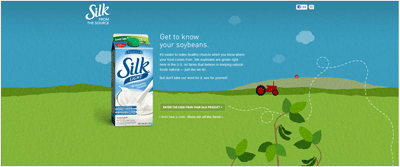The Big Picture: The traceability trend
NEW WEBSITE ALLOWS CONSUMERS TO TRACE THEIR SOY BEVERAGE BACK TO THE FIELD
wanting to know where our food comes from is a growing phenomenon among consumers. The country of origin often drives spending in the produce aisle as consumers look for the apples grown in Canada rather than those grown stateside. In fact, the trend has transcended the produce department and entered the meat aisle at many grocery stores. At the local grocery store in Guelph, an image of the smiling farmer that raised the cow that is soon to become dinner is printed directly on the package.
The traceability trend is based on the increasing need to feel connected with our food. Although it is true that many – some would argue most – Canadians aren’t all that interested in where their food comes from or how it’s grown, there is a growing segment of the population that is seeking out information and some companies have made an effort to provide it.
Unfortunately for grain and oilseed farmers, the more steps involved in turning a farm product into a food product increases the difficulty of using traceability as a marketing and education tool. It’s much simpler to explain that an apple came from an orchard in Blenheim than it is to highlight the fact that the corn in your table syrup came from a field near Fergus. This disconnect, combined with the current farm infrastructure that allows traceability for food safety but not to such an extent that it can be used for marketing, makes it rare to see grains and oilseed products marketed in this way.
But, soybeans have just joined the traceability train. Silk Soymilk has recently introduced a campaign where consumers can enter a code from their carton online to see where the soy in their soy beverage came from. Soy beverages may not be as many processing steps away from the field as table syrup – the crop name is found in the product title – but it’s certainly interesting to see a new focus on the traceability of an oilseed.
The website, www.silksoymilk.com/traceit provides information not about specific farms but more generalized information about many farms in specific counties and states. The site features charming graphics and lots of farm photos showing the different stages of a soybean crop in the field; each photo is coordinated with a specific county.
The site is also heavy with information about genetic modification and loudly flaunts the fact that Silk Soymilk is made with non-GMO beans. Although this may frustrate farmers who choose to grow GMO beans, one needs to look beyond this specific feature and see how this trend may be applicable to other grain and oilseed products.
Currently, the campaign is only running in the US highlighting American farms, however, it may be that Silk is on the first wave of a developing trend. We may not be too far away from a photo of a wheat farmer on frozen English muffins or an image of a corn farm on cereal. •


















